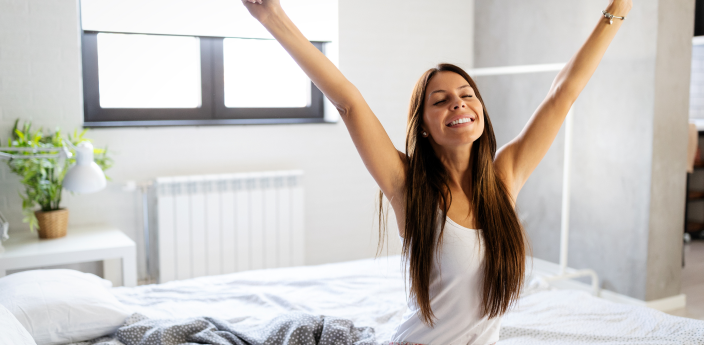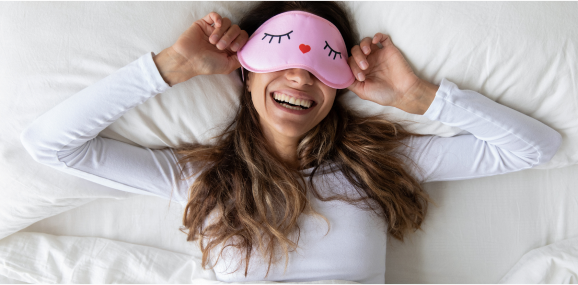“There’s got to be a way to get better sleep.” If you’ve said or thought this, you’ve probably experienced multiple nights of sleeplessness.
Sleep problems aren’t isolated to those with sleeping disorders, and finding ways to get restful sleep can seem harder than finding the needle in the haystack. What’s even more frustrating is experiencing a lack of sleep when your body genuinely feels tired.
At Hug Sleep, we understand sleep issues. In fact, we’ve had them ourselves. Being plagued by poor sleep can cause side effects that interfere with your ability to function during the day and may even negatively impact your mental health.
If you’ve had issues getting to sleep even though you feel sleepy, we’re here to help. Together, we’ll cover what makes our bodies sleep, what you can do to establish a solid sleep pattern, and how to build better sleep habits so your body can get the rest it needs.
What Makes Us Sleep?
As children, it seemed so easy. You have a busy day of play, your body gets tired, and you tuck into bed for some much-needed, healthy sleep.
As adults, the process starts getting complicated. With age (plus stress from jobs, finances, relationships, and a myriad of other factors), the bodily processes that help us sleep can go a little haywire.
So, although your circadian rhythm, sleep drive, and central nervous system are all designed to help you fall asleep, they can actually interfere with the rest you need.
Circadian Rhythm
Your circadian rhythm is also referred to as your internal clock. This system uses light to help determine when your body and mind should be awake or asleep. Responsible for mental and behavioral changes, your circadian rhythm also signals your body when it’s time to begin releasing melatonin.
Because your circadian rhythm relies on light, people who do shift work may have a circadian rhythm that is not in line with when they actually need rest. Traveling between time zones can also interfere with your circadian rhythm.
Sleep Drive
Your sleep drive is like a gas tank. When you wake up from a great night of sleep, your sleep drive is full. As you expend energy throughout your day, your sleep drive (the tank) begins to empty, requiring sleep to fill it. When your sleep drive is empty, it signals your body to go to sleep by making you feel tired and ready for bed.
Your sleep drive and circadian rhythm work together to prepare you for sleep and then keep you awake the next day when you rise. However, there’s a third element that can really interfere with sleep quality: your nervous system.
The Nervous System Link
Your nervous system also plays a big part in whether or not you’re ready for sleep. The nervous system is pretty complicated, and some parts are not fully understood, especially when it comes to how they interact with your sleep cycle.
There are, however, two big components that help tell your body and mind to stay awake or go to sleep. They are the sympathetic nervous system (SNS) and the parasympathetic nervous system (PSNS).
- SNS: The SNS is responsible for triggering hormone releases of cortisol and adrenaline and is an important part of your “fight or flight” response. The SNS also keeps your body and mind awake, so if it doesn’t turn off when it should, you could be in for a long night.
- PSNS: The PSNS is the opposing force to the SNS. The PSNS helps slow your heart rate, triggers the release of feel-good hormones like serotonin and dopamine, and even helps your muscles relax.
In a perfect system, the SNS gradually slows at the end of your day, making room for the PSNS to take over and help you prepare for sleep. Unfortunately, the system doesn’t always work this way.
Tired or Fatigued: What’s the Difference?
Being tired and fatigued are two different experiences, and it’s important to know the difference. If you’re simply tired, you may not be able to sleep.
Feeling fatigued means your body is out of energy. It’s the same feeling you get when you run a race or engage in a particularly grueling workout. You may not have the energy to take another step, but you aren’t necessarily tired and ready for bed.
Tiredness, on the other hand, happens when our sleep drive signals that we need to sleep. This can result from a combination of fatigue and other factors like your circadian rhythm — but fatigue alone won’t usually help you sleep.
Tired But Can’t Sleep?
Feeling tired and unable to sleep is frustrating, but once you figure out the cause, you’ll be one step closer to a solution. Here are some common reasons you may feel tired but not be able to nod off.
Diet
The way diet affects your sleep isn’t completely understood. Studies do indicate a relationship between your macronutrient intake and whether or not you’ll be tired during the day or night, but the evidence isn’t yet clear enough to say eating a particular food will keep you awake.
That said, eating sugar before bed can be problematic. Sugar raises your blood glucose levels and requires your body to start producing insulin to metabolize it. This can raise your core body temperature, which can cause trouble sleeping.
Stimulants
It goes without saying that drinking an energy drink before bed is a bad idea, but the caffeine you drink in the afternoon could still be keeping you awake at night. Try to establish a cut-off time for caffeine and other stimulants during your day so your brain won’t buzz with random thoughts and trivia facts at night.
Blue Light
Blue light rays have short, high-energy wavelengths. A natural part of the light spectrum, blue light is emitted from the sun — but also from devices like your smartphones, LED televisions, and fluorescent light bulbs.
It may seem relaxing to scroll through your phone before bed, but blue light interferes with your circadian rhythm, fooling it into thinking it’s time to be awake. This can inhibit the release of melatonin and keep you alert longer.
Sleep Disorders
Sometimes, sleep issues are bigger than just a few nights of insomnia. Sleep disorders like sleep apnea, narcolepsy, and restless leg syndrome can make it difficult to sleep even when you’re tired. If you have one of these health conditions, it’s important to talk to your doctor about finding a solution.
It’s also a good idea to talk to your doctor if you’re experiencing chronic insomnia or sleep deprivation that lasts for longer than three weeks.
The Sympathetic Nervous System
Yes, the SNS could be a contributing factor to your inability to rest. When the SNS doesn’t shut off, it thwarts the efforts of your sleep drive and your circadian rhythm. That means your body might feel tired and in need of rest, but because the SNS still has you in business mode, you can’t fall asleep.
Although it can be extremely frustrating, there are ways you can help your SNS wind down and move towards the rest you need. Here are some tips for getting to sleep when your body feels tired but won’t switch off.
Tips and Tricks for When You’re Tired But Can’t Sleep
Everyone suffers from sleeplessness from time to time. But if it’s starting to become a pattern, here are some tips and tricks to help you settle your mind and relax your body.
Practice Good Sleep Hygiene
Sleep hygiene is the habits and behaviors that are conducive to helping you sleep well. These habits can include cognitive behavioral therapy for insomnia (CBT-I), relaxation techniques like deep breathing and meditation, or actively redirecting your thoughts about sleep away from negative outcomes (like not being able to sleep).
Good sleep hygiene also involves preparing your sleep environment. Ensuring there is little noise, no bright lights, and a cool temperature can help keep your room ready for rest.
Develop a Sleep Schedule
When your sleep is erratic, it can be hard for your body’s circadian rhythm to function properly. For instance, if you have a late work deadline and are pumping coffee late at night, your sleep schedule could be thrown off for a few days.
Developing a set time for bed each night can give you a better chance of sleeping more soundly.
Get a Better Blanket
If you’ve tried a weighted blanket and felt a little weighed down, we understand. Sometimes, weighted blankets don’t work, but the science behind them is worth exploring: deep touch pressure therapy, or DTPT.
How Deep Touch Pressure Therapy Works
Deep Touch Pressure Therapy, or DTPT, involves gentle pressure on certain parts of the body, similar to squeezing or hugging. This type of pressure helps activate the PSNS, allowing you to relax, stimulating the right hormones to lull your body to rest.
Think of it like an air traffic controller helping move your SNS off the runway to make way for the PSNS to land.
The Sleep Pod
DTPT is an easy process, especially with the Hug Sleep Sleep Pod, a blanket you can wear.
The Sleep Pod was designed to provide this crucial sensory stimulation without the weight of a weighted blanket. The breathable, four-way stretch fabric gives you deep pressure stimulation that still allows for complete mobility and feels comfortable under the covers or by itself.
For sleepers who’d prefer to have their feet free to move about, the Sleep Pod Move allows total foot freedom.
Get the Rest You Need When You Need It
When you’re tired but too restless to sleep, grab the only blanket that hugs you back. The Sleep Pod gives you the sensory stimulation you need to begin drifting towards sleep.
Not all heroes wear capes — but the well-rested ones probably wear Sleep Pods.
Sources:
What Is Deep Pressure Stimulation? | Applied Behavior Analysis Edu.org
Circadian Rhythms | National Institute of General Medical Sciences
Cognitive Behavioral Therapy for Insomnia (CBT-I) | Sleep Foundation

































500,000+ happy customers